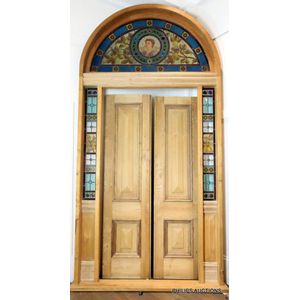Victorian Stained Glass Door Surround with Fruit Branches
You must be a subscriber, and be logged in to view price and dealer details.
Subscribe Now to view actual auction price for this item
When you subscribe, you have the option of setting the currency in which to display prices to $Au, $US, $NZ or Stg.
- Lead Statuary and Objects - Lead is a soft, heavy, with a low melting point, making it suitable for detailed moulding. Because of its durability and resistance to corrosion it is suitable for outdoor applications, which has led to its extensive use in garden statues and objects since Roman times.
It develops a silver-grey to lead-grey patina over time.
For garden statuary and objects, it is also a less expensive material to use, than bronze or stone.
However its softness is also a disadvantage as garden statuary made from lead is easily damaged, especially if moulded as a hollow, as for example, in a human or animal form. - Roundel - A roundel is a circular disk, medallion or border on a plate or dish, on an object of furniture. A plate or dish will often have a central circular bordered decoration, termed a roundel. In furniture the word is often used instead of the word 'patera' to describe a turned circular decoration. In recent times use of the word has expanded to encompass any circular area on an object.
- Victorian Period - The Victorian period of furniture and decorative arts design covers the reign of Queen Victoria from 1837 to 1901. There was not one dominant style of furniture in the Victorian period. Designers used and modified many historical styles such as Gothic, Tudor, Elizabethan, English Rococo, Neoclassical and others, although use of some styles, such as English Rococo and Gothic tended to dominate the furniture manufacture of the period.
The Victorian period was preceded by the Regency and William IV periods, and followed by the Edwardian period, named for Edward VII (1841 ? 1910) who was King of the United Kingdom and the British Dominions and Emperor of India for the brief period from 1901 until his death in 1910.
This item has been included into following indexes:
Visually similar items

Whipple, (20th century) American, Deckchairs at the beach + Nuns flying Kites (2), each oil on board, each signed lower right, each 12 x 12 cm

A French walnut bibliotheque in the Henri II style, circa 1880, with a finely moulded cornice surmounted by a gallery with spindles, foliate scrolls and finials above two full length partly glazed and panelled doors flanked by full length fluted and turned

19th century mahogany breakfront library bookcase with moulded cornice, four lancet arched astragal doors, the base with four panel doors, on box base

A French oak display cabinet in the Louis XVI style, circa 1920, having an arched pediment with a garland and crossed torch and quiver motif, above a row of relief carved scrolls, two full length shaped and bevel glazed doors flanked by pendant husk motifs
